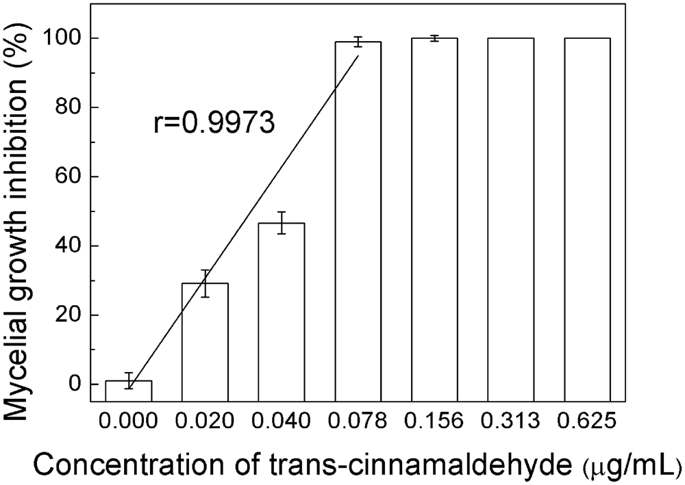Scientific Reports ( IF 3.8 ) Pub Date : 2019-01-24 , DOI: 10.1038/s41598-018-36989-7 Fei Huang 1, 2, 3 , Jie Kong 1, 2, 3 , Jian Ju 1, 2, 3 , Ying Zhang 1, 2, 3 , Yahui Guo 1, 2, 3 , Yuliang Cheng 1, 2, 3 , He Qian 1, 2, 3 , Yunfei Xie 1, 2, 3 , Weirong Yao 1, 2, 3

|
The antifungal mechanism of essential oils against fungi remains in the shallow study. In this paper, antifungal mechanism of trans-cinnamaldehyde against Penicillium italicum was explored. Trans-cinnamaldehyde exhibited strong mycelial growth inhibition against Penicillium italicum, with minimum inhibitory concentration of 0.313 μg/mL. Conventional analytical tests showed that trans-cinnamaldehyde changed the cell membrane permeability, which led to the leakage of some materials. Meanwhile, the membrane integrity and cell wall integrity also changed. Surface-enhanced Raman spectroscopy, an ultrasensitive and fingerprint method, was served as a bran-new method to study the antifungal mechanism. Characteristic peaks of supernatant obviously changed at 734, 1244, 1330, 1338 and 1466 cm−1. The Raman intensity represented a strong correlation with results from conventional methods, which made SERS an alternative to study antifungal process. All evidences implied that trans-cinnamaldehyde exerts its antifungal capacity against Penicillium italicum via membrane damage mechanism.
中文翻译:

使用表面增强拉曼光谱(SERS),膜损伤机制有助于抑制意大利青霉上的反式肉桂醛。
精油对真菌的抗真菌机制仍在浅层研究中。本文研究了反式肉桂醛对意大利青霉的抗真菌作用机理。反式肉桂醛对意大利青霉菌具有强烈的菌丝生长抑制作用,最低抑制浓度为0.313μg/ mL。常规分析测试表明,反式肉桂醛会改变细胞膜的通透性,从而导致某些物质的泄漏。同时,膜的完整性和细胞壁的完整性也发生了变化。表面增强拉曼光谱,一种超灵敏的指纹方法,被用作研究抗真菌机理的全新方法。上清液的特征峰在734、1244、1330、1338和1466 cm处发生明显变化-1。拉曼强度与常规方法的结果具有很强的相关性,这使SERS成为研究抗真菌过程的替代方法。所有证据表明反式肉桂醛通过膜破坏机制发挥了对Italicum青霉的抗真菌能力。

































 京公网安备 11010802027423号
京公网安备 11010802027423号